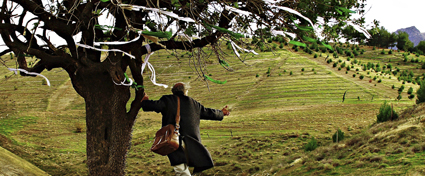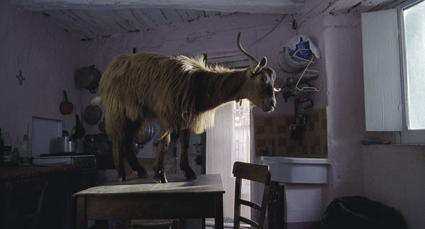serious competition: life vs art
tom redwood: preview, 2011 bigpond adelaide film festival

Whisper with the Wind
photo Javad Jalali
Whisper with the Wind
IF A POSITIVE SPIN CAN BE MADE OF THE FLAGRANT MONOPOLISATION OF WHAT WE USED TO CALL ART-HOUSE CINEMAS IN THIS COUNTRY, IT IS THE INCREASED RESPONSIBILITY THAT AUSTRALIAN FILM FESTIVALS NOW HAVE TO EXHIBIT DIVERSE, UNIQUE AND VITAL FILMS FROM ALL PARTS OF OUR WORLD. WE KNOW WE WON’T SEE MUCH BEYOND BATMAN FOR THE REST OF THE YEAR (UNLESS WE LOOK REALLY HARD), SO WHEN OUR LOCAL FESTIVAL COMES ALONG IT BECOMES NECESSARY TO BEHAVE MUCH AS A CAMEL WOULD AT AN OASIS, AND FILL UP WITH A YEAR OR TWO’S WORTH OF INTERESTING CINEMA IN A FEW SHORT DAYS.
Festivals are, of course, not immune to the kind of intimidation of which small independent cinemas are clearly victims. Festival organisers too can succumb to the fear that an unusual, ‘excessively internationalist’ program won’t attract an audience weaned on superheroes. It’s extremely pleasing then, when a young film festival like Adelaide’s holds firm to its original game plan and offers a spread of films designed to challenge rather than appease its audience.
Since 2007 the Adelaide film festival has been headlined by its competition group, a selection of a dozen films often indicative of the program at large. This year the competition’s emphasis on stylistically distinctive cinema continues. Established masters like Raoul Ruiz and Patricio Guzman line up next to newcomers and lesser-knowns like Kurdish Shahram Alidi and Australian Beck Cole (whose debut feature Here I Am premieres at the festival). And for the first time two documentaries are included in competition: Guzman’s Nostalgia for the Light (Nostalgia de la Luz) and Australian Mathew Bate’s Shut Up Little Man! An Audio Mis-Adventure.
The decision to include documentaries in competition is as bold as it is curious, and it could be asked how a documentary can be fairly evaluated against narrative films in a prize for ‘best feature.’ Oddly enough, the inclusion is rather fitting for this year’s selection. More than a couple of those entries designated as ‘narrative features’ are themselves barely narratives at all, or at least barely fiction. One of the standout artistic merits of this year’s competition is that so many of the films carefully traverse the gap between life and art. The distinction between documentary and fiction becomes a lot less clear cut than we might assume it to be.
Radu Muntean’s Tuesday, After Christmas (Marti, Dupa Craciun) is a remarkable case in point, another gem from the current wave of great Romanian cinema. It combines a modest but passionate interest in adult relationships with a long take style that might be called bravura were it not so unassuming. Moving his camera only when necessary, and yet also refusing to cut into the action in order to drive a point home, Muntean respectfully and very skilfully allows his actors and his audience space to experience and interpret the story, that of a man who follows his heart wherever it goes and the ensuing catastrophe this brings his family. This is a truly great accomplishment of cinematic realism, wholly avoiding dogma in both tone and message. Some films we watch because they offer us a view of another world, others we can watch because they reveal our own lives taking place in another country.

The Four Times (La Quattro Volte)
If Tuesday, After Christmas offers a seamless kind of domestic realism, two other films in this year’s competition present a more poetic type of realism, of life beyond the day-to-day. Quite unlike anything I have ever seen, Michelangelo Frammartino’s The Four Times (La Quattro Volte) is a wordless ‘narrative’ that follows the transmigratory passage of a dying Calabrian goat-herd’s soul from human incarnation to animal (a baby goat), to vegetable (a pine tree) and finally to mineral (charcoal). Unusual though the plot may be (you might care to think of something more unusual) the filmmaker’s approach to the mystical content is anything but fantastical. Again, with extremely restrained long takes (many several minutes long) the action presents itself as a perfectly natural course of events. As with much great realist cinema, what the Four Times offers is an awareness of the world as a work of art, and of our movement through it.
Similarly in Year Without A Summer, Malaysian director Tan Chui Mui takes us on a journey that is as much about its setting as its characters. Long departed and forgotten friend Azam returns to his childhood fishing village, emerging from the sea like some monster to spend the night with his dear friend Ali and Ali’s wife Minah. Bobbing in their small boat on the moonlit ocean the friends rejoice with memories and folk tales, themselves resembling mythical figures in a watery dream world. Things suddenly change however, when the film returns to the much harsher world of Azam’s childhood. An elusive and very lyrical film, Year Without A Summer displays Tan Chui Mui’s highly developed visual sensitivity. The way digital video is used to capture moonlight on the Malaysian coast is alone reason enough to see this film.
More lyrical still is the Kurdish elegy Whisper with the Wind (Sirta la gal ba), winner of the Young Critics Award at Cannes. Paradoxically both eclectic and solemn, Whisper with the Wind conveys the period and place of the Kurdish genocides, known as ANFAL, which took place in the late 1980s in Kurdistan (Northern Iraq) under Saddam Hussein. The opening titles inform us that during these years 32,000 Kurds were murdered, many buried alive (though other estimates suggest as many as 180,000). Following the trail of message carrier Mam Baldar through decimated Kurdish communities, Whisper in the Wind presents a poetic and harrowing portrait of this profoundly troubling event. Whether or not the Kurdish genocide validates, or is in any way related to, the 2003 invasion of Iraq is not a question easily answered. What is certain is that a film like this in the 2011 competition powerfully illustrates the vital role that film festivals can play in a sheltered culture like Australia’s.
Other entries in competition for the International Award for Best Feature include the Peruvian black comedy October (Octubre) directed by brothers Daniel and Diego Vega, Kelly Reichardt’s acclaimed indie American western Meek’s Cutoff and Canadian writer-director Denis Villeneuve’s Incendies.
2011 Bigpond Adelaide Film Festival, Feb 24-March 6; www.adelaidefilmfestival.org
RealTime issue #101 Feb-March 2011 pg. 29






